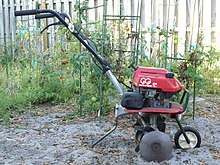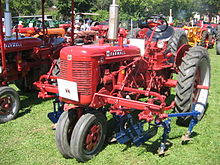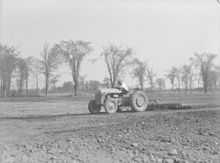
Back مسلفة Arabic Мотофреза Bulgarian Conreadora Catalan Grubber German Kulturmaŝino Esperanto Cultivador Spanish Kultivaator Estonian Lurra lantzeko makina Basque کولتیواتور Persian Kultivaattori Finnish
This article needs additional citations for verification. (July 2011) |





A cultivator is a piece of agricultural equipment used for secondary tillage. One sense of the name refers to frames with teeth (also called shanks) that pierce the soil as they are dragged through it linearly. It also refers to machines that use the rotary motion of disks or teeth to accomplish a similar result. The rotary tiller is a principal example.
Cultivators stir and pulverize the soil, either before planting (to aerate the soil and prepare a smooth, loose seedbed) or after the crop has begun growing (to kill weeds—controlled disturbance of the topsoil close to the crop plants kills the surrounding weeds by uprooting them, burying their leaves to disrupt their photosynthesis or a combination of both). Unlike a harrow, which disturbs the entire surface of the soil, cultivators are designed to disturb the soil in careful patterns, sparing the crop plants but disrupting the weeds.[1]
Cultivators of the toothed type are often similar in form to chisel plows, but their goals are different. Cultivators' teeth work near the surface, usually for weed control, whereas chisel plow shanks work deep beneath the surface, breaking up the hardened layer on top.
Small toothed cultivators pushed or pulled by a single person are used as garden tools for small-scale gardening, such as for the household's own use or for small market gardens. Similarly sized rotary tillers combine the functions of a harrow and cultivator into one multipurpose machine.
Cultivators are usually either self-propelled or drawn as an attachment behind either a two-wheel tractor or four-wheel tractor. For two-wheel tractors, they are usually rigidly fixed and powered via couplings to the tractors' transmission. For four-wheel tractors they are usually attached by means of a three-point hitch and driven by a power take-off . Drawbar hookup is also still commonly used worldwide. Draft-animal power is sometimes still used today, being somewhat common in developing nations although rare in more industrialized economies.
- ^ morc. "Difference Between Cultivator And Harrow – Types & More". tractornews.in. Retrieved 2023-08-24.
© MMXXIII Rich X Search. We shall prevail. All rights reserved. Rich X Search